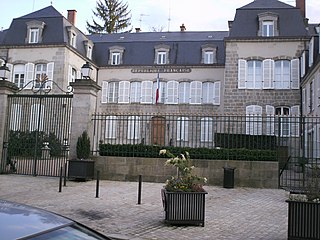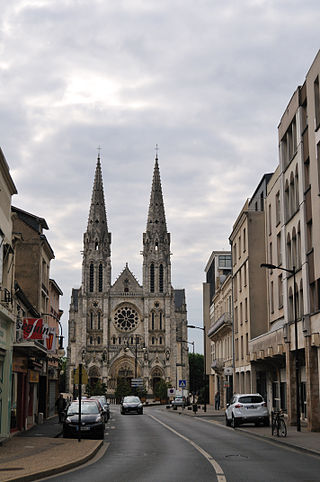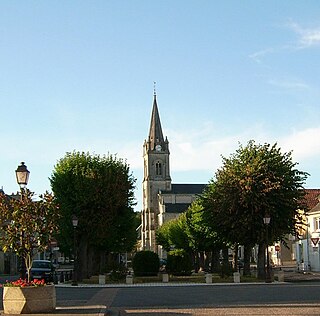
Aubusson is a commune in the Creuse department region in central France.

Creuse is a department in central France named after the river Creuse. After Lozère, it is the second least populated department in France. It is bordered by Indre and Cher to the north, Allier and Puy-de-Dôme to the east, Corrèze to the south, and Haute-Vienne to the west. In 2020, the population of this department is 115,995, while the official estimates in 2022 is 113,711.

Indre ; is a department in central France named after the river Indre. The inhabitants of the department are known as the Indriens and Indriennes. Indre is part of the current administrative region of Centre-Val de Loire. The region is bordered by the departments of Indre-et-Loire to the west, Loir-et-Cher to the north, Cher to the east, Creuse and Haute-Vienne to the south, and Vienne to the southwest. The préfecture (capital) is Châteauroux and there are three subpréfectures at Le Blanc, La Châtre and Issoudun. It had a population of 219,316 in 2019. It also contains the geographic centre of Metropolitan France.

Haute-Vienne is a département in the Nouvelle-Aquitaine region in southwest-central France. Named after the Vienne River, it is one of the twelve départements that together constitute Nouvelle-Aquitaine. The prefecture and largest city in the department is Limoges, the other towns in the department each having fewer than twenty thousand inhabitants. Haute-Vienne had a population of 372,359 in 2019.

Châteauroux is the capital city of the French department of Indre, central France and the second-largest town in the province of Berry, after Bourges. Its residents are called Castelroussins in French.

Guéret is a commune and the prefecture of the Creuse department in the Nouvelle-Aquitaine region in central France.

Le Blanc is a commune and a subprefecture of the department of Indre, and the region of Centre-Val de Loire, central France.

Montluçon is a commune in central France on the river Cher. It is the largest commune in the Allier department, although the department's prefecture is located in the smaller town of Moulins. Its inhabitants are known as Montluçonnais. The town is in the traditional province of Bourbonnais and was part of the mediaeval duchy of Bourbon.

Yzeures-sur-Creuse is a commune in the department of Indre-et-Loire, Centre-Val de Loire, France.

Descartes is a large village and commune in the Indre-et-Loire department in central France. It is approximately 29 kilometers east of Richelieu and about 48 kilometers east of Loudun, on the banks of the Creuse River, near the border of the French department of Vienne, and the border of the region between Centre-Val de Loire and Nouvelle-Aquitaine. It is famous for the birthplace of the French mathematician and philosopher who invented the Cartesian coordinate system, René Descartes.

Loches is a commune in the department of Indre-et-Loire, Centre-Val de Loire, France.

The Route nationale 20 (N20) is a trunk road (nationale) between Paris and the frontier with Spain heading south through the heart of France and passing through the Cathedral City of Orléans and Toulouse. The road forks at Col de Puymorens with one branch being the Route nationale 22 which leads to Andorra. In winter, avalanches sometimes close the road.

The A20 autoroute or L'Occitane is a highway through central France. A part of France's national network of autoroutes, it is 427 kilometres (265 mi) long.

Ahun is a commune in the Creuse department in the Nouvelle-Aquitaine region in central France.

The Roman city of Argentomagus was located in the Mersans plateau of central France, at the strategic point on the north bank of the river Creuse, where a Roman bridge once traversed. It was located at the crossing of two roads—Cenabum (Orléans) to Augustoritum (Limoges), and Limonum (Poitiers) to Avaricum (Bourges). The Latin name of the city meant "Silver Market." The modern town of Argenton takes its name from the ancient site of Argentomagus.

Tournon-Saint-Martin is a commune in the Indre department in central France.

Néons-sur-Creuse is a commune in the Indre department in central France.
The canton of Argenton-sur-Creuse is an administrative division of the Indre department, central France. Its borders were modified at the French canton reorganisation which came into effect in March 2015. Its seat is in Argenton-sur-Creuse.

Argenton-sur-Creuse station is a railway station in France on the Orléans–Montauban railway, located within the commune of Argenton-sur-Creuse, in the département of Indre, in the Centre-Val de Loire region. It is an SNCF train station served by trains of the Intercités and TER Centre-Val de Loire networks.






















